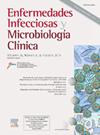埃及南尼氏菌引起的皮肤炎:墨西哥西部报告155例
IF 2.5
4区 医学
Q3 INFECTIOUS DISEASES
Enfermedades infecciosas y microbiologia clinica
Pub Date : 2025-04-01
DOI:10.1016/j.eimc.2024.08.011
引用次数: 0
摘要
背景:由gypsea Nannizzia引起的皮肤真菌病被认为是罕见的。临床表现与其他皮肤真菌产生的症状难以区分,但是,由于这是一种嗜土真菌,它可以引起更多的炎症性疾病。MethodsRetrospective研究。在哈利斯科州皮肤病研究所观察到吉普赛奈瑟菌培养阳性的患者。其中包括2001年至2023年的乔斯·芭芭·卢比奥。调查频率、性别、年龄、进化和临床变异。我们比较了儿童和成人的研究结果。采用描述性统计和推断性统计。结果23年间确诊155例(每年6.7例)。女性占多数(53.5%)。中位年龄为9岁(最小1岁,最大85岁),发病较多的年龄组为1 ~ 10岁(54.2%)。进化时间中位数为30天(最小1天,最大3年),74.8%的进化时间≤30天。头癣以儿科患者为主(41.0%,P <;.01),而成人以体癣为主(72.7%,P <;. 01)。炎症性癣在儿科人群中更为普遍(21.0% vs. 3.6%, P <;. 01)。结论石膏乳杆菌引起炎症性癣的能力主要见于儿科患者。由于没有临床数据怀疑这种真菌,因此始终有必要进行真菌学研究以确定物种并实施适当的治疗。本文章由计算机程序翻译,如有差异,请以英文原文为准。
Dermatofitosis causadas por Nannizzia gypsea: informe de 155 casos en el oeste de México
Background
Dermatophytosis caused by Nannizzia gypsea are considered rare. The clinical picture is indistinguishable from that produced by other dermatophytes, but, being this a geophilic fungus, it can cause more inflammatory disease.
Methods
Retrospective study. Patients with positive culture for N. gypsea observed at the Dermatological Institute of Jalisco «Dr. José Barba Rubio», from 2001 to 2023, were included. Frequency, sex, age, evolution, and clinical variant were investigated. We compared the findings between the pediatric versus adult population. Descriptive and inferential statistics were used.
Results
Over 23 years, 155 patients were diagnosed (6.7 cases per year). Female sex predominated (53.5%). The median age was 9 years (minimum 1 year and maximum 85 years), the more affected age group was 1 to 10 years (54.2%). The median time of evolution was 30 days (minimum one day and maximum 3 years), and 74.8% had an evolution ≤ 30 days. Tinea capitis predominated in pediatric patients (41.0%, P < .01) whereas tinea corporis predominated in adults (72.7%, P < .01). Inflammatory tinea was more prevalent in the pediatric population (21.0% vs. 3.6%, P < .01).
Conclusion
The ability of N. gypsea to cause inflammatory tinea was observed primarily in pediatric patients. Since there is no clinical data to suspect this fungus, it will always be necessary to carry out a mycological study to identify the species and to implement the appropriate treatment.
求助全文
通过发布文献求助,成功后即可免费获取论文全文。
去求助
来源期刊
CiteScore
2.10
自引率
8.00%
发文量
194
审稿时长
29 days
期刊介绍:
Hoy está universalmente reconocida la renovada y creciente importancia de la patología infecciosa: aparición de nuevos agentes patógenos, de cepas resistentes, de procesos con expresión clínica hasta ahora desconocida, de cuadros de una gran complejidad. Paralelamente, la Microbiología y la Infectología Clínicas han experimentado un gran desarrollo como respuesta al reto planteado por la actual patología infecciosa. Enfermedades Infecciosas y Microbiología Clínica es la Publicación Oficial de la Sociedad Española SEIMC. Cumple con la garantía científica de esta Sociedad, la doble función de difundir trabajos de investigación, tanto clínicos como microbiológicos, referidos a la patología infecciosa, y contribuye a la formación continuada de los interesados en aquella patología mediante artículos orientados a ese fin y elaborados por autores de la mayor calificación invitados por la revista.

 求助内容:
求助内容: 应助结果提醒方式:
应助结果提醒方式:


